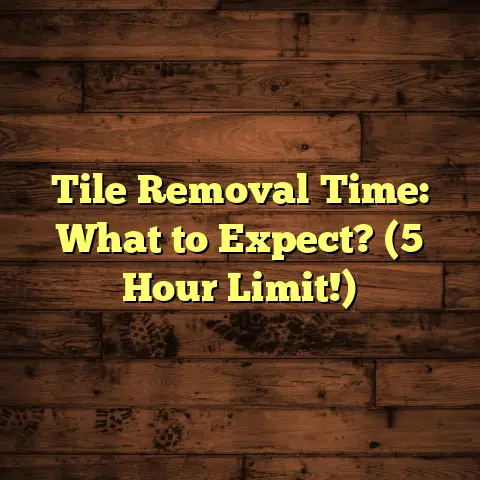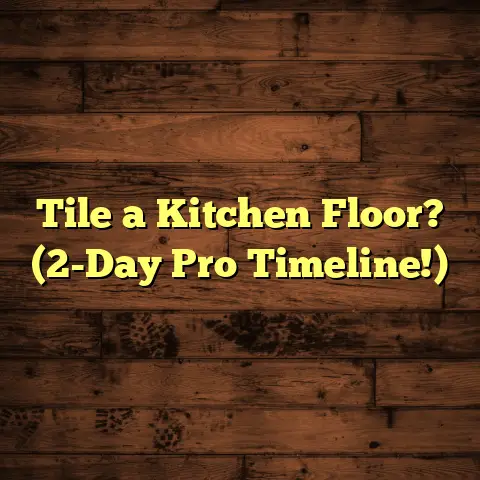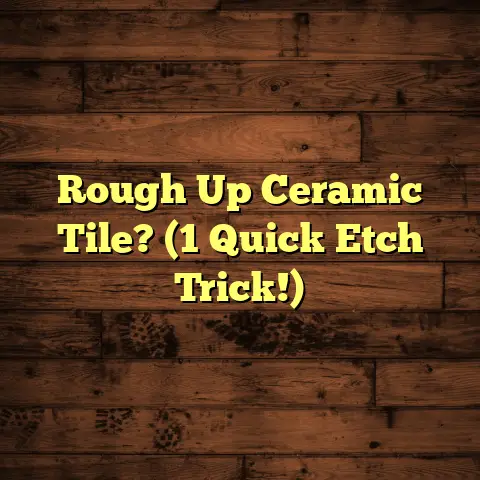Laminate Putty: Quick Floor Fix Guide (3 Min Fix!)
Ever walk into a room and your eyes immediately land on that glaring scratch on your laminate floor?
It’s like a tiny imperfection that screams for attention, right? I get it. As a flooring contractor for over 15 years, I’ve seen countless homeowners struggle with this exact frustration.
Kids playing, pets running, furniture shifting – life happens, and laminate floors often bear the brunt of it. But don’t despair! There’s a super easy, super-fast solution: laminate putty.
And I’m here to tell you all about it.
Section 1: Understanding Laminate Flooring
What is Laminate Flooring?
Laminate flooring is basically a multi-layer synthetic flooring product fused together through a lamination process. Think of it like a photo – you have a base, the image itself, and then a protective layer on top.
-
Wear Layer: This is the top, transparent layer that protects against scratches, stains, and fading.
-
Decorative Layer: This is the photographic image that gives the laminate its look – wood, stone, tile, you name it.
-
Core Board: This is the main body of the plank, usually made of high-density fiberboard (HDF) or medium-density fiberboard (MDF).
-
Backing Layer: This bottom layer provides stability and helps protect against moisture.
Laminate’s popularity stems from its affordability, durability, and ease of installation. It’s a great alternative to hardwood, especially for budget-conscious homeowners.
Advantages:
- More affordable than hardwood.
- Easy to install (often click-lock systems).
- Durable and scratch-resistant (to a degree).
- Easy to clean.
- Wide variety of styles and colors.
Disadvantages:
- Not as water-resistant as vinyl.
- Can sound hollow underfoot.
- Not repairable like hardwood (unless you use putty!).
- Lower resale value compared to hardwood.
Common Issues with Laminate Flooring
Okay, let’s be real. Laminate isn’t invincible. Here are some common problems I see all the time:
-
Scratches: These are the most common, caused by everything from pet claws to dragging furniture.
-
Dents: Heavy objects or sharp impacts can cause dents, especially in lower-quality laminate.
-
Gaps: These can appear between planks due to improper installation, humidity changes, or settling.
-
Chipped Edges: Edges can chip, especially in high-traffic areas.
-
Water Damage: While some laminates are water-resistant, they’re not waterproof. Spills need to be cleaned up quickly to prevent swelling and warping.
These issues often arise from:
- Heavy Foot Traffic: Constant wear and tear.
- Pet Claws: Those adorable fur babies can wreak havoc.
- Dragging Furniture: Always lift, never drag!
- Improper Installation: This is huge! If the subfloor isn’t level or the planks aren’t properly locked, problems are inevitable.
- Lack of Maintenance: Neglecting cleaning and protective measures can accelerate wear and tear.
Section 2: Introducing Laminate Putty
What is Laminate Putty?
Laminate putty, also known as laminate filler or repair paste, is a pliable substance designed to fill in scratches, dents, and gaps in laminate flooring. It’s basically a cosmetic fix, but it can make a HUGE difference in the appearance of your floor.
It comes in a variety of colors to match different laminate shades, and it’s usually available in tubes or small containers.
There are a few different types of putty available:
-
Acrylic-Based Putty: This is the most common type, and it’s easy to work with. It dries relatively quickly and can be sanded and painted.
-
Epoxy-Based Putty: This is a stronger, more durable option, but it’s also more difficult to work with. It’s a good choice for larger repairs or areas that will see a lot of wear and tear.
-
Wax-Based Putty: This type is often used for filling in small scratches. It’s easy to apply, but it’s not as durable as acrylic or epoxy putty.
Why Use Laminate Putty?
Okay, so why not just replace the entire floor? Well, that’s expensive and time-consuming! Laminate putty offers several advantages:
-
Ease of Use: Seriously, anyone can do it. It’s like playing with Play-Doh.
-
Cost-Effectiveness: A tube of putty is a fraction of the cost of replacing even a single plank.
-
Quick Application: As the title suggests, you can often fix a small scratch in just a few minutes.
-
Color Matching: Putty comes in a wide range of colors, so you can usually find a close match to your flooring.
-
Hides Imperfections: It effectively conceals scratches, dents, and small gaps, making your floor look much better.
Compared to other repair methods, like replacing planks or using wood filler, laminate putty is a no-brainer for minor damage. It’s the quick, easy, and affordable solution you’ve been looking for.
Section 3: The 3-Minute Fix – Step-by-Step Guide
Alright, let’s get down to business! Here’s how to fix that annoying scratch in just a few minutes.
Gather Your Tools and Materials
Before you start, make sure you have everything you need:
-
Laminate Putty: Choose a color that closely matches your flooring. It’s often better to go a shade lighter than darker.
-
Putty Knife: A small, flexible putty knife is ideal for applying and smoothing the putty.
-
Cleaning Supplies: A damp cloth and some mild cleaner to clean the area.
-
Optional: Sandpaper (Fine Grit): For smoothing out any imperfections after the putty dries.
-
Optional: Soft Cloth: For buffing the area after sanding.
Prepare the Area
This is crucial! You can’t just slap putty on a dirty surface.
-
Clean the Damaged Area: Use a damp cloth and mild cleaner to remove any dirt, dust, or debris from the scratch or dent.
-
Dry the Area: Make sure the area is completely dry before applying the putty.
Why is this important? Because the putty needs to adhere properly to the laminate surface. Dirt and grime will prevent a good bond, and the putty will likely crack or peel over time.
Applying Laminate Putty
Okay, now for the fun part!
-
Apply a Small Amount of Putty: Using the putty knife, scoop up a small amount of putty and apply it to the scratch or dent. Don’t overdo it!
-
Overfill Slightly: It’s better to slightly overfill the area than to underfill it. The putty will shrink slightly as it dries.
-
Smooth and Level: Use the putty knife to smooth the putty and level it with the surrounding surface. Apply gentle pressure and use short, overlapping strokes.
-
Remove Excess Putty: Use the edge of the putty knife to scrape away any excess putty from the surrounding area. You want a smooth, seamless finish.
Tips for Choosing the Right Color:
- Test in an Inconspicuous Area: Before applying the putty to the damaged area, test it in a hidden spot to make sure the color is a good match.
- Mix Colors: If you can’t find a perfect match, consider mixing two different shades of putty to create a custom color.
- Go Lighter: As I mentioned before, it’s usually better to go a shade lighter than darker. A lighter color will be less noticeable than a darker color.
Drying and Finishing Touches
Patience is key!
-
Allow to Dry: Let the putty dry completely according to the manufacturer’s instructions. This usually takes a few hours, but it can vary depending on the type of putty and the humidity.
-
Sand (Optional): If the putty is not perfectly smooth after it dries, you can gently sand it with fine-grit sandpaper. Use light pressure and sand in the direction of the wood grain (if applicable).
-
Buff (Optional): After sanding, buff the area with a soft cloth to remove any sanding dust and restore the shine.
And that’s it! You’ve successfully fixed a scratch in your laminate floor in just a few minutes.
Section 4: Real-Life Applications and Success Stories
Okay, enough with the theory. Let’s see some real-world examples of how laminate putty can save the day.
Case Studies
Case Study 1: The Scratched Living Room Floor
I had a client, Sarah, who had a beautiful living room with laminate flooring. But her two energetic dogs had left several scratches on the floor near the patio door.
She was devastated! She thought she would have to replace the entire floor. I suggested trying laminate putty first.
We found a putty that closely matched her flooring, and I showed her how to apply it. She was amazed at how easy it was!
After the putty dried, she gently sanded the area and buffed it with a soft cloth. The scratches were gone! She was so happy, she almost cried.
Before: Scratches near the patio door, very visible.
After: Scratches filled and blended seamlessly with the surrounding floor.
Case Study 2: The Dented Kitchen Floor
Another client, John, dropped a heavy pot on his kitchen floor, leaving a noticeable dent. He was worried about water getting into the dent and causing further damage.
I recommended using epoxy-based laminate putty for this repair, as it’s more durable and water-resistant.
He followed my instructions, and the dent was filled in perfectly. He was so impressed with the results, he decided to use the putty to fix a few other minor imperfections in his floor.
Before: A visible dent in the kitchen floor from a dropped pot.
After: The dent filled and smoothed over with epoxy putty.
Testimonials
“I was so frustrated with the scratches on my laminate floor. I thought I would have to replace the entire thing. But then I found laminate putty! It was so easy to use, and it completely transformed my floor. I highly recommend it!” – Mary, Homeowner
“I’m not a very handy person, but I was able to fix a dent in my laminate floor with laminate putty in just a few minutes. It’s amazing! Thank you!” – Tom, Homeowner
Section 5: Maintenance Tips for Longevity
Okay, you’ve fixed the problem. Now, how do you prevent it from happening again?
Preventative Measures
-
Use Protective Pads Under Furniture: This is HUGE! Felt pads under furniture legs will prevent scratches and dents.
-
Sweep or Vacuum Regularly: Dirt and grit can act like sandpaper, scratching your floor over time.
-
Clean Up Spills Immediately: Don’t let spills sit on your floor, as they can cause water damage.
-
Use a Doormat: Place a doormat at entrances to trap dirt and debris before they get onto your floor.
-
Trim Pet Nails: Keep your pet’s nails trimmed to minimize scratches.
When to Seek Professional Help
While laminate putty is great for minor repairs, it’s not a miracle worker. There are some situations where you’ll need to call in the pros:
-
Extensive Water Damage: If your floor is severely warped or swollen due to water damage, putty won’t fix it.
-
Large Gaps: If you have large gaps between planks, it could indicate a more serious installation problem.
-
Loose or Buckling Planks: This could be a sign of subfloor issues or improper installation.
-
You’re Not Comfortable Doing It Yourself: If you’re not confident in your DIY skills, it’s always best to call a professional.
Conclusion
So there you have it! Laminate putty is a quick, easy, and affordable solution for fixing minor imperfections in your laminate floor.
With just a few simple steps, you can transform your flooring woes into triumphs in just three minutes.
Don’t let those scratches and dents get you down. Take charge of your home maintenance and give laminate putty a try. You’ll be amazed at the difference it can make!
And remember, a little preventative maintenance goes a long way in keeping your laminate floor looking its best for years to come.
Now go forth and conquer those floor imperfections! You got this!





